ᶀƦ⟲Ⱪ3ᥒ ⟒Ɍ3𐆖𐆖𐆖⟳ⱤĐƵ (AKA: Broken Records: Hystories i of Noise && Dirty New Media)
jonCates
CHICAGO 2011
COPY-IT-RIGHT
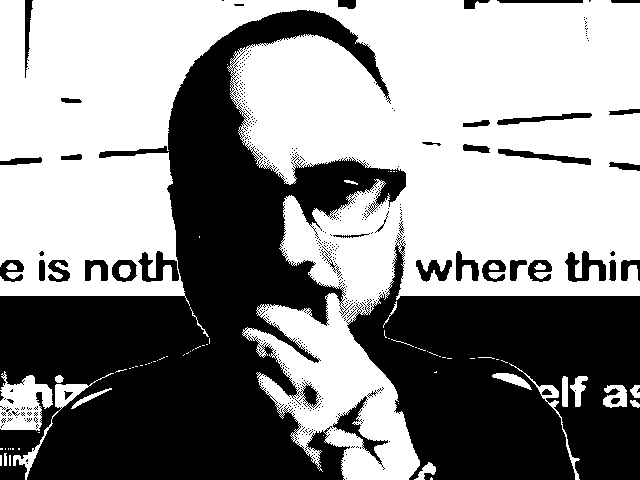
jonCates presenting !NV0(ɔ)4XXX!0N555 @ Glitch exhibition
curated by John Pomara and Dean Terry, CentralTrak (2011)
"Technologies cannot be neutral," as Shane Mecklenburger writes in his exhibition text for the recent exhibition simply entitled "Glitch". ii The non-neutrality of technology which Mecklenburger references is made clear through disciplines of thought and action such as Science and Technology Studies, Software Studies and Glitch Art. We have learned this lesson through recent iterations of McLuhan, Baudrillard and Kittler. WJT Mitchell and Mark BN Hansen have recently written that: "Media can no longer be dismissed as neutral or transparent, subordinate or merely supplemental to the information they convey." iii In the introduction to Friedrich A. Kittler's Gramophone, film, typewriter, Geoffrey Winthrop-Young and Michael Wutz refer to Jean Baudrillard's Requiem for the Media in which Baudrillard argued against the neutrality of media/technologies. iv These thoughts/feelings and actions are a continuity, a conversation, a critical discourse calling attention to our predicament as increasingly technologized subjects of global capitalism and corporatist regimes.
The corporate logic of our consumer computing devices relies on false promises of - or rather belies broken hopes for - functionality; or rather is constructed/proposed on the basis of lies which coverup a coercive force in the form or fabric of functionality. Business models are among the most operative metaphors of everyday computing culture. The international business machines we use run embedded concepts such as the "desktop" metaphor. The digital world in which we live efficient and highly productive lives is individuated through hypercapitalism. We actively design and consume ourselves through our digital culture in micropayments made real from the speculative dreams of Xanadu imagined by Ted Nelson to the iOS integration of App Store purchases and accounts managed by Apple Computers. The isolated individuality of the single user keyboard and screen arrives to us in hindsight through a McLuhanesque rear-view window future: inherited from Burroughs Corporation’s calculators and International Business Machines' typewriters, mixed with the mechanics of radio and televisions, illuminated by the bright weaponized light of utopian military industrial enthusiasm from the American 1940s.
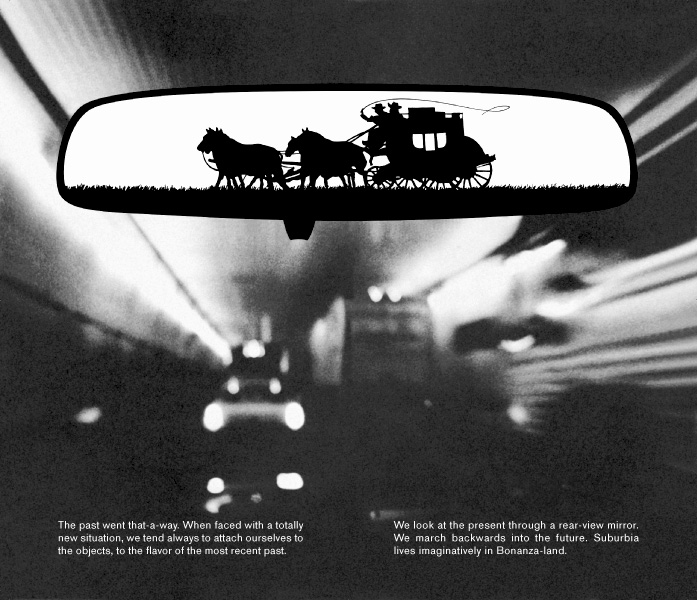
The Medium is the Massage - Marshall McLuhan, Quentin Fiore and Jerome Agel (1967)
We are also connected to other memories and hystories in personal, subjective, interpreted, encoded, shared, plural, diffuse and divergent networks of meaning. Alan Kay and Adele Goldberg gave us a gift, a glimpse of playfulness or convivial tools, as inspired by Ivan Illich, to rethink the destructive power of global capital, spectacular consumption and coercive inculcation claiming to be 'educational' forms. First generation Net Artists, experimental New Media pioneers/path-cutters and Glitch.err(s) such as JODI inspire us to be "curious cats" who "just wanna push programs over the edge". v Mayhaps this curiosity comes with a cost, as Eddo Stern has suggested, in a conversation with me, that artistic positions such as these run the risk of perching too precariously on an ever-moving/mediated edge which is made believed in waves of technosocial sharpness (a cultural currency) and premeditated dullness (as forms fall into planned obsolescence) then into nostalgic waters (kept warm by our own autobiographies) by the self same corporate cultures we critique.
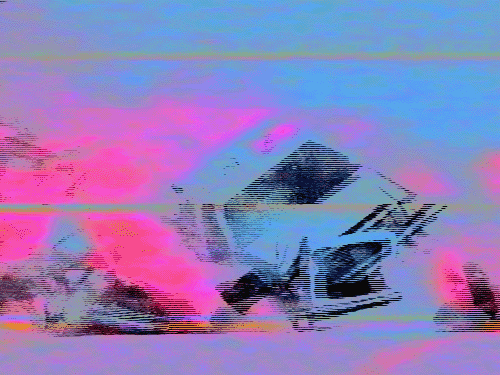
X1172 - MAX CAPACITY (2011)
"Crash is also all about uncertainty... Crash exposes a vast range of social, political and computational issues at the same time as itself acting or signifying exposure. Crash can readily be seen as the exposure of the programmable and machinic in that what perhaps was not necessarily viewed as a machine or as coded is now revealed as such." - Martin Howse (of ap/xxxxx) vi
For me, these are sum of the troubles, facts and feelings of living in our impure Digital<>Analog worlds. I was born in the Late Analog Era listening to experimental Electronic Music, Stereo System Test Recordings and Kraftwerk's Autobahn from my father's vinyl collection and playing back my Commodore 64 software as raw data on cassette tapes. Electronic Music often anticipates Digital Art methods, models and aestheticonceptechniques. vii This is the result of simple pragmatics of computing and processing power in which operations as basic as copy/paste or as complex as synthesis and realtime processing are hystorically implemented on increasingly complex data formats (i.e. first in plain text, programming languages, then in audio and later in video capabilities). Digital sampling forms a conceptual basis for the conversion of the Analog Era into contemporary Digital Cultures. Analog operates as points of origin which simultaneously co-exist with and mayhaps are better rendered by the language of 'singular'-ness in relation to the Digital. Analog: singular. Digital: plural; multiple; instantiated...
"We hear the distant sound, as if from the sky, the sound of a breaking string, dying away mournfully. Silence ensues, and all we hear far away in the orchard is the thud of an axe on a tree." - Anton Chekhov viii
"During sleep, recurrent connections within the hippocampus force a coherent code to form from noise..." - A. David Redish and David S. Touretzky ix
While re/constructing a few/sum hystories of Noise && Dirty New Media in this text, I want to think/feel through Experimental Musics as understood through the academic lens of artistic Avant Gardes as well as pop-cultural forms. From the early 1900's to today, Luigi Russolo's much-invoked manifesto, L'Arte dei Rumori (The Art of Noises) may have cast a spell which now includes, in retrospect, events from: the 1970's work of Kraftwerk, COUM Transmissions becoming Throbbing Gristle becoming Psychic TV or rather Psychick TV or rather the Thee Temple ov Psychick Youth as a conceptually inconsecrated way of discussing the development of Industrial Musics to the later 1980's supposed subgenres of EBM (Electronic Body Music) and/or cultures of Cybergoth x to early 1990's origins of IDM (Intelligent Dance Music) to mid-1990's Rhythmic Noise to the late 1990's origins of Digital Hardcore and Dubstep to the early 2000's microsound or rather Clicks & Cuts or rather post-techno and more currently the preset variations of Glitch Hop as expressed through presets, filters and VST plugins such as Ableton Live's Deconstruct filter (located in the Beat Repeat category) or Kieran Foster's (ILLFORMED's) directly named "Glitch" VST plug-in from 2005. xi
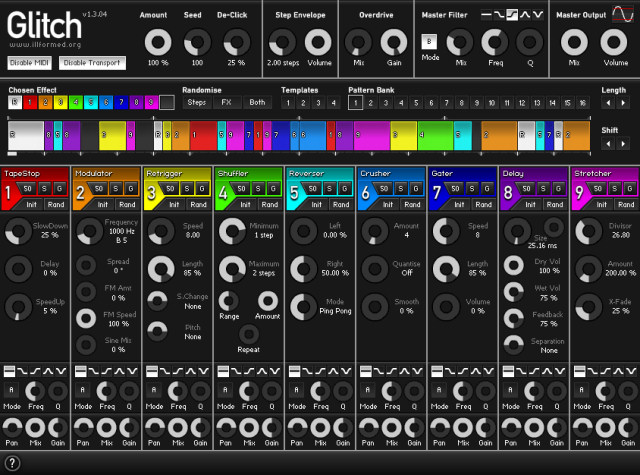
"Glitch" VST plug-in - ILLFORMED (Kieran Foster) (2005)
Kodwo Eshun says, of his concept of remixologies in Iara Lee's documentary Modulations, that the remixological approach is the "convergence of all kinds of musics that in their own form would never have mixed". xii While running lipstick traces xiii over linear hystories, Eshun describes these combinatory effects/affects as implosions. His choices of words are always intentional and intentionally poetic but betray the nonlinear dynamics of implosions, of destructive processes of collapse. Like Lyotardian collapses of narrative or imploding Cathode Ray Tube screens, these destructive moments are creative breaks or rather ruptures. These ruptures or breaks are also openings into newly created interstices. As Rosa Menkman has articulated, we intentionally inhabit these spaces and/or generate them, break in and open them this way because "noise and glitches are (often) about breaking or pushing boundaries and relaying the membranes of what is socially accepted as categories or genre." xiv
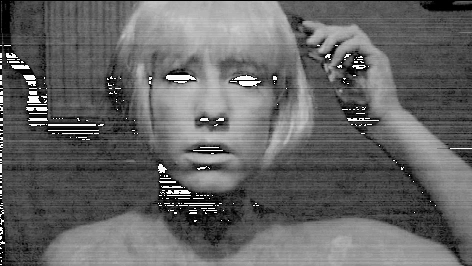
TIFF Compression glitch - Rosa Menkman (2010)
"Cracked Ray Tube is a collaborative realtime project by Chicago artists Kyle Evans and James Connolly that combines analog television and vga monitor feedback hacks." - http://crackedraytube.com
“Noise music, in its many alterations, ruptures conventional generic boundaries: it is often not music at all, but noise, or sound, combined with visual material... it escapes the closure of the (theatrical) stage... When staged, the relation between performer and everyday person is blurred, and participation by audience members in Noise events is, in specific instances, a distinctive phenomenon.” - Csaba Toth xv
"Static between stations. Rain. We want to capture and control these sounds, to use them, not as sound effects, but as musical instruments..." - John Cage xvi
"Don Delillo’s more contemporary novel White Noise is said to be centered around the ideas of consumerism, death, and the way the two fold back upon one another. I would argue that these ideas could be seen as a melancholic response to the permanent present." - Timothy C. Schwartz xvii
"We drove 22 miles into the country around Farmington. There were meadows and apple orchards. White fences trailed through the rolling fields. Soon the sign started appearing. THE MOST PHOTOGRAPHED BARN IN AMERICA... "We're not here to capture an image, we're here to maintain one. Every photograph reinforces the aura. Can you feel it, Jack? An accumulation of nameless energies... Being here is a kind of spiritual surrender. We see only what the others see. The thousands who were here in the past, those who will come in the future. We've agreed to be part of a collective perception... They are taking pictures of taking pictures," he said. He did not speak for a while. We listened to the incessant clicking of shutter release buttons, the rustling crank of levers that advanced the film." - Don Delillo xviii
i read White Noise when i was in college in the middle of the midwest at a university no so much unlike The-College-on-the-Hill of Delillo's novel, populated by professors not unlike Delillo's characters Jack Gladney and Murray Jay Siskind, who conversed with me in ways that made reading White Noise feel as if i was simply stepping into a slightly parallel stream, a nearby reality sharing similar paths, elements and connection points. It was then that i determined to teach, reading bell hooks and considering crashing systems as breakdown/throughs to othersides, the openings of potentially radical possibilities such as the micro-revolutionary ethics of Guttarri. my art practice and goals for teaching already at the time were based on Network Cultures (heavily influenced then by Geert Lovink and nettime), Experimental Musics (although more closely aligned then with DJ and Rave cultures through Digital Hardcore, Ambient, Industrial and other more 'experimental' takes on dance musics) and what would now be called Glitch Art approaches (of breakdown, rupture, self-reflexivity, systems crashes, error messages, hard cuts, downsampling, bitcrushing, etc...). It was through these academic pursuits that i built a basis for a community in Chicago, a community formed through context-building, a context developed out of this set of concerns in order to articulate, question, open and share these intersections. Our community became a framework, openly proposed for participation and interpretation by those in the Noise and New Media Art communities connected through efforts to engage and in fact develop discourses relevant to these combinatory affects.
For Evan Meaney, glitch (mayhaps intentionally lowercased) is a process of internalization as glitch is "much less about an aggressive push outward, than it is about an acceptance. these glitches are present and accounted for both outside our bodies and within. and, if they are so pervasive, then really they can't be subversive or transgressive." xix Glitch is a system with and within ourselves which we can and do learn to love, in their infinite philosophic returns as included imperfections we once tried to abandon but now integrate. Mayhaps also Glitch returns to us after our leavetakings as if we are "taking in an orphan" xx or a once orphaned attachment, relations that lingers 'most inevitably' inherited like mythologies from Western European traditions in the shape of ghostly figures half remembered/rendered through collective imaginings of complexes, of problematics, repeated forms of: Electra, Edipus and/or Sysiphus... Philosophies of fixation, the concept of glitch as pathologized and/or embraced.
These are then always already moments in which we are made aware of contextualizing, of making meanings and/or enframings. We are world building through networks of meanings made meaningful to each other through connecting, through choice making and artistic intentionalities. In this glitched theorypractice we must thereby be and become aware of ourselves in processes that either seek to function invisibly (such as the multithreaded processes that run in aggregate shape as our 'computer desktops') or render us invisible (i.e. through overperformed commercialized individuations in hypercapitalism). In either case, we can choose (to sum extent), as our choices are seen to effect processes, we can literally (not metaphorically, metaphysically or in the abstract) break, bend, hack, crack, corrupt, crash, misinterpret, deconstruct, bitcrush, disorder, forget, misfile, traumatize, degrade, mistake and/or misencode... these systems as well as these glitches themselves... as when a recent remix of mine made Meaney feel as if he had broken the break, making him 'maybe afraid of putting it back together again' xxi like the legend of an egg in the language of well-known nursery rhyme or rather a melody, a song to be sung, as part of a folkloric tradition. This song has also echoed in, remixed through Lewis Carrol's original version of Alice in Wonderland:
“When I use a word,” Humpty Dumpty said, in rather a scornful tone, “it means just what I choose it to mean - neither more nor less.”
“The question is,” said Alice, “whether you can make words mean so many different things.”
“The question is,” said Humpty Dumpty, “which is to be master - that’s all.”
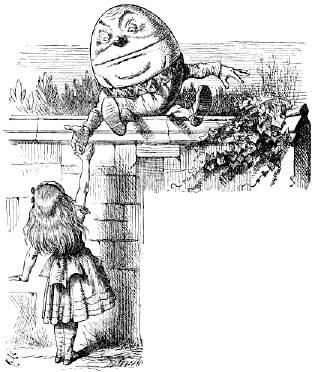
Humpty Dumpty - (as illustrated by) John Tenniel (1865)
What falls from the quotes above is what i mean by: 'we make meanings through choices of what and when to break when we glitch, when we master (making) imperfections which undermine concepts of technological mastery by highlighting our complex(/es/ities of) meaning making, unmaking, demaking'... by breaking and/or bending meanings to make new shapes. From the digitalPunk perspective this is the process of burnt, re:started states, ripped up and started again, fragmentary reassemblages, in the known futures of experimental New Media. As the formerly named Rotten, John Lydon has written: "I know there's a certain aspect in my character where I actually enjoy things falling apart..." xxii But and/or also: "I don't think anything about the Pistols was nihilistic. We certainly weren't on a death trip. Maybe it was wreck-and-destroy stupidity, but I would hardly think that's nihilistic. Quite the opposite. It's very constructive because we were offering an alternative." xxiii Or like Motorcycle Boy said, once upon a Rumble Fish: "You know, if you're gonna lead people, you have to have somewhere to go." xxiv
From the academic perspective invoked earlier, Noise is a type of music which comes from musical traditions such as Musique concrète and Art Historically originates from Futurist, Dadaist, Surrealist and FLUXUS. xxv Nearby, the term 'realtime' refers to receiving and processing a continuous signal at the same rate as the signal is produced. Contemporary computers are able to produce and process datastreams (i.e. audio and video) in realtime. These realtime systems thereby allow digitization (sampling from the analog), resampling, transcoding, synthesis, generation of born-digital data and feedback (which is itself often a feature of Noise musics). Live performance interactions with these audio-video systems and streams can recurse, like codes falling infinitely in on/of themselves, flooding stacks and overrunning buffers that break like eggs and leak memory as if it was (at least linguistically) fluid. Unstable fluids fill unstable media xxvi, awash in memories made warm by our seemingly ongoing need to personify and/or anthropomorphize machines, make species-specific biological metaphors as models to understand devices of our own making or comfort ourselves in the face of our own fears of approaching technological singularities beyond which we have no capacities to imagine.
For me these are the recent futures and nearby pasts in which Glitch, Noise and Dirty New Media connect and/or coalesce which is why when the GLI.TC/H organizers initially asked me, back towards the end of 2009, about how to frame/organize the event, i suggested a focus on the intersections of Noise & New Media Art. xxvii Menkman herself has also framed the conversation in these terms, utilizing 'Artifacts' as an enframing device to describe the apparatus of glitch as an expanded field of technosocial interrelations. The specific Chicago community that i have worked to develop and discourses i have enabled attempts to connect concepts of Noise and dirtiness of New Art, i.e. digitalPunk, Dirty New Media and Glitch Art in ways that literally correspond to and connect with communities of Noise Music and musicians. The r4WB1t5 micro-festivals, which i initiated with Jon Satrom and organized with an expansive group of artist-participant-organizers over the years (from 2005 – 2007) explicitly focused on these intersections. xxviii
In the field of Noise Music a definition exists and is mobilized by Noise musicians to identify "Harsh Noise" from other forms of Noise Music. The harshness of Harsh Noise musics relates to the music itself (i.e via high volumes, extreme amplitude shifts, dramatic and dynamic jumps through frequency ranges, abrupt rhythmic changes, shifts in tempo from non-movement to movement, etc) as well as the reception of the music (i.e. in the experience of listening to Harsh Noise music performances). Harsh Noise is harsh. Glitch Art is glitched. But is it harsh? Or, is it necessarily always harsh, hard-edged or crunchy? Such were the questions posed by New Media artist and Media Art Histories scholar Paul Hertz to Rosa Menkman in Chicago during the first GLI.TC/H festival of Noise & New Media. Menkman's response (as we walked along Wabash Avenue beside and underneath train tracks that recall the trains that travel in her "The Collapse of PAL" performance/video) was "no, not necessarily..." and i would add that Glitch Art is often also cyberpsychedelic.
i use the term cyberpsychedelic to refer to the combinatory effects of mixing Cybernetics and Psychedelics as cultural influences. In his work on the countercultural origins of cybercultures, Fred Turner refers “small-scale technologies of psychedelia” including personal digital and analog computing systems, electronic musical forms and perception (mind and mood) altering drugs such as marijuana and LSD. I will refer to the combination of cybernetics (in terms of feedback systems enabled by realtime technologies) and psychedelics as 'cyberpsychedelic'. As i argue in other Media Art Histories research projects, i understand these small-scale cyberpsychedelic technologies to be designed technologies of personal transformation (or tools for conviviality as described by Ivan Illich xxix) as well as being aestheticonceptechnics. The work of Morgan Higby-Flowers expresses the situations i am describing as Higby-Flowers' work is both harsh and flowing, cyberpsychedelic and noisy realtime Glitch Art performances.

Morgan Higby Flowers at GLI.TC/H - (photo by) Rosa Menkman (2010)
Higby-Flowers' "Input == Input” performance illustrated above with a photo and screenshots is as Bent Festival 2011 curator Phillip Stearns restates, of Higby-Flowers' definition of his process, a: “Realtime audio visual performance using a no-input system. The output ranges from dirt-filthy, loud, and stroboscopic : to soft, rhyth matic NTSC rivers. Past performances of Input==Input include the fist international GLI.TC/H conference/festival in Chicago, the Performance Video Event in NYC sponsored by the New Media Caucus, and PeepShow 2011 curated by the Squeaky Wheel in Buffalo, NY." xxx Higby-Flowers' work is cyberpsychedelic, hard edged with rough edges along steep stairsteps of anti-aliased imagery and simultaneously abrupt jumps and smooth transitions of multilayered feedback patterns in the soundscapes which he produces by performing live in realtime. Higby-Flowers recent performance at the BENT Festival held at 319 Scholes in Brooklyn operated precisely in this manner as has his work since time when he began exploring these approaches while studying with me at The School of the Art Institute of Chicago when Higby-Flowers began to perform his realtime audio-video Glitch Art projects in the context of The School, outside events (such as those taking place at the Flowershop in Chicago) and the r4WB1t5 micro.fest in Mexico City.
While in New York for this year's BENT Festival to see Higby-Flowers and other friends, including those who were also involved in r4WB1t5 (Arcangel Constantini and Juanjose Rivas), i recently encountered BENT Festival's own description of itself, written by curator Phillip Stearns in 2011. Stearns' description of the festival does sum work to recast itself or revise the BENT Festival's history in order to align BENT Festival more directly with Glitch Art by making an implicit claim that the festival is and always has been about glitch when in fact the 2011 Curatorial Statement introduces the term which was previously not included in the conception of BENT Festival. Stearns' 2011 Curatorial Statement for BENT also introduces a direct comparison to punk as a motivation for 'breakages' in Media Art and experimental Musics. As he begins his text, Stearns claims that these conerns or this curatorial/organizational approach was unknown before BENT began. xxxi while his motivation for making this claim is understandable from a promotional perspective, his claim is nonetheless clearly a convenient fiction (as i am demonstrating in this text) and a predictable form of myopia informed by NYCentricism (which is prevalent especially in the .US) mixed with an ahistoricism which would seek to intentionally lapse into permanent states of willing amnesia about precedents and prehystories.
10 years before this most recent BENT Festival, in the summer of 2001, i went to Rob Ray's Deadtech Gallery in Chicago for "Post-Data in the Age of Low Potential, Pt. 2 The first ever Beige gallery exhibition" in which they exhibited, for the first time, their "proprietary 8-bit Nintendo Entertainment System movies, along with ASCII video and various prints." xxxii My memory of the event is itself a bit distressed over time, slow faded to he point that i actually remember it taking place instead at an artspace called Heaven rather than DEADTECH. in any case, that summer BEIGE started playing a regular night at a Chicago venue, called Double Door, in a part of the space called Dirt Room:
"THE 8 BIT CONSTRUCTION SET (St.Louis/Chicago/NYC)
fat bits and post data;; the first software distribution on vinyl -- ever!!;; nasty home made 8 Bit Rave Trax, hacked Nintendo games;; wicked DJ action;; EXCLUSIVE: the Beige Massive Magic Show!!" xxxiii
BEIGE events quickly commanded the attention of the communities which i work in and develop, especially in the Chicago-based New Media Art communities and the academic environment of New Media Art at The School of the Art Institute of Chicago, both of which became foundational to our current Glitch Art context. xxxiv
BEIGE was funny then and the members of the now disbanded collective are still individually funny and famously mobilize humor in their projects. They were also very serious and had a serious attachment to positions they were taking and making in the world. One such position or attachment of theirs was expressed through the project Low Level All Stars. Low Level All Stars, now usually singularly credited to Cory Arcangel 'of BEIGE Programming Ensemble' and RSG, AKA Radical Software Group (which is in most cases a 'group' made up of a single individual, Alexander R. Galloway), xxxv articulates a particular position that BEIGE developed and extended into the New Media Art worlds we share/d. Low Level All Stars is a curated collection of crack screen intros from pirated Commodore 64 game software. The cracks themselves are then recracked in this collaboration which is "MADE DIRECTLY FROM THE C64 WITH NO COMPUTER EMULATION." xxxvi This project represents motivations and intents as do other BEIGE projects. Among these intentionalities, BEIGE associated itself with Hacker/Cracker cultures xxxvii and represented itself collectively and themselves individually as hackers/crackers. xxxviii
As with the 2 examples previously footnoted, these associations and representations were variously/simultaneously ironic, sarcastic and serious. Representing oneself this way involves demonstrating control of and operating from a position of LEET low level programming skills. Hacker Culture is a type of Expert Culture. These experts often function outside of more traditionally recognized legitimizing structures such as academia but are nonetheless experts and have created and maintained their own (albeit often highly individualized, self-educated and iconoclastic) legitimating technosocial structures, processes and reward systems. I have experienced these issues from inside of Hacker/Cracker cultures and have my own individual and collective takes on working with and within those frameworks. xxxix BEIGE made serious and playful claims in the early 2000's about existing between these legitimating structures; belonging to and being adept in the intersected fields of hacking, cracking, New Media Art and experimental musics. In 2003, i co-organized the Version Festival series at The Museum of Contemporary Art in Chicago. i asked BEIGE to speak on their projects and they presented their work on Nintendo hacking, the 6502 assembly programming language and Nintendo system architecture.
8 BIT presentation - BEIGE at Version>03 Festival, The Museum of Contemporary Art in Chicago (2003)
i had already begun thinking critically about their positions and what they would begin referring to/proposing as their Dirt Style. In the same Festival, the criticalartware project which i co-founded, core-developed and cared for xl curated an Artware exhibition called "artists_software_development". xli We intentionally developed this exhibition to foreground Artware of Media Art hystorical relevance to us and others (i.e. rather than only works produced in/on then current formats). We chose to develop a GUI interface to this physically installed and digitally based exhibition that would simulate a criticalartware Operating System xlii imagined as a version of Smalltalk and rendered using (then) Macromedia Flash. The choice of Flash (now owned by and branded as Adobe Flash) was performed in direct relation to the positions described earlier which were held by BEIGE. This was a subtle and mayhaps underrecognized form of communication or dialogue between both of our then Chicago-based collectives/collaboratives/groups.
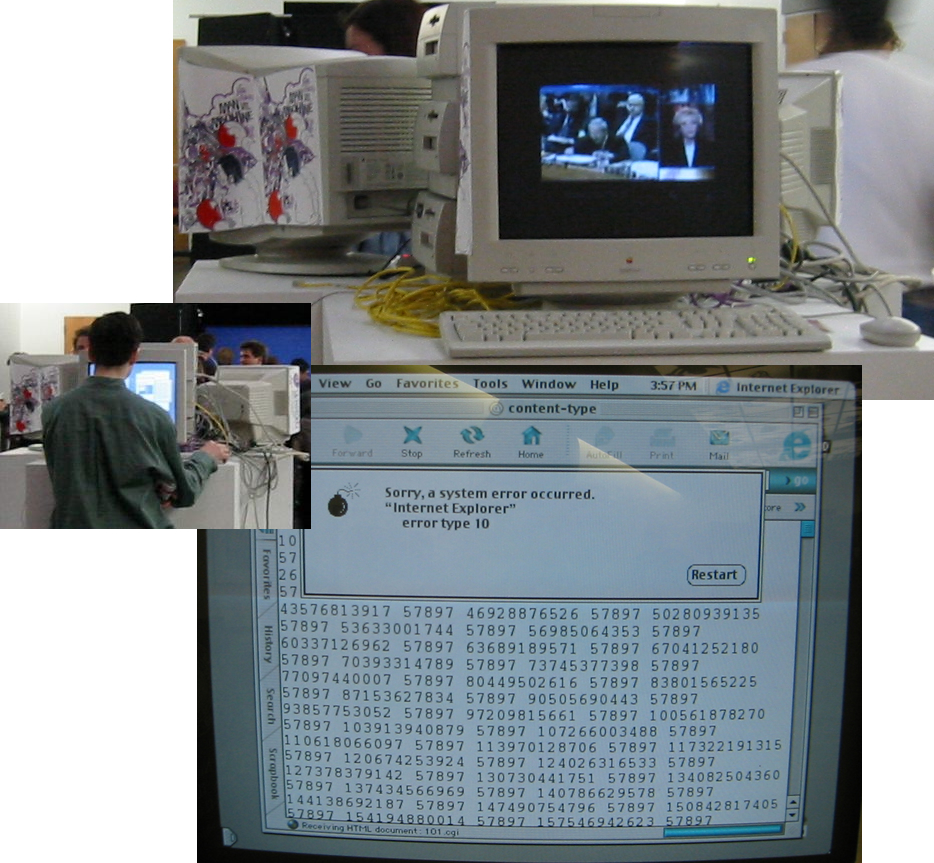
"artists_software_development" artware exhibition – criticalartware at Version>03, Museum of Contemporary Art in Chicago (2003)
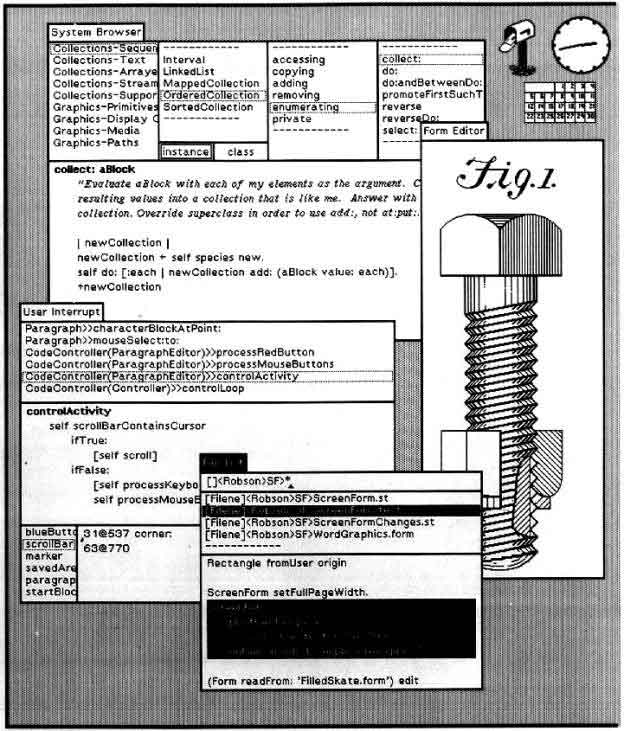
"The SmallTalk development and GUI environment"
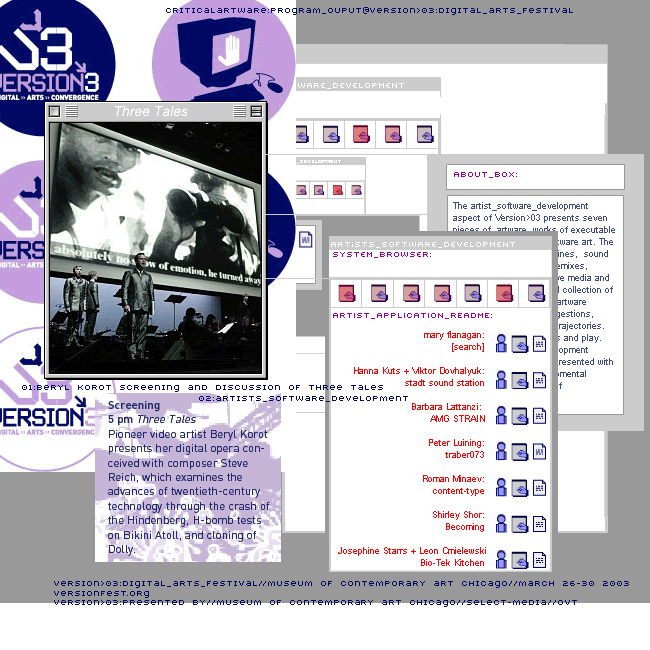
"artists_software_development" artware exhibition – criticalartware at Version>03, Museum of Contemporary Art in Chicago (2003)
In their presentation BEIGE spoke about their goal of low level programming as a way to be close enough to the core operations of the machine in order to avoid other agendas such as those imposed by software via the corporate logic such software emerges from as commercial products of consumer computing. Flash, as an example, was invoked by BEIGE collectively and as individuals as a negative example of how software obscures artistic intent by distancing the artist from their medium or materials. xliii As expressed in the "Beige Philosophy" page on their website, BEIGE believes in the "quick and easy exchange of information" versus complexity, mystery or corporate logics such as passive consumption modeled after previous mass media formats (i.e. television). xliv
By 2005 i had left the organizing effort for the Version Festivals and was recentering/refocusing on organizing New Media Art events that would be smaller scale, faster (mayhaps even in a mode after BEIGE's expressed philosophy). xlv My interest then and now is on a dirtiness of New Media Art that could embrace forms of brokenness (what is now referred to generally as Glitch Art) with a set of meanings of 'dirtiness' that refer to punk, digital sampling, piracy, pornography, fetish, etc... in the context of the communities i have been describing and particularly the affects, effects and impacts of the discourses i/we have developed and deployed at various moments which importantly includes and is inspired by a take on/interpretation of/response to the Dirt Style collaboratively/collectively developed by BEIGE.
As such, Dirty New Media is a term i began to use around 2005 after having been thinking/feeling through BEIGE's Dirt Style for a few years. i meant to express a contrast with the kind of cleanliness that i associate with more commercial or corporate styles of Digital Art and Design. The graphic and industrial design styles of Apple Computers is a perfect example of the kind of clean, smooth, slick style i am referring to. My reason for saying Dirty New Media is to express a difference or resistance to these imaginary forms of cleanliness. My and our communities’ work is thereby intentionally more raw, direct, dirty, glitchy, noisy, etc. This is a Glitch Art style that i/we have developed in collaboration, conversation and critical dialogue. xlvi Jason Scott, archivist for Archive.org, has called our Chicago-based community the "birthplace of dirty new media". xlvii Menkman has written that we foreground Glitch Art in a way which has become a 'pivotal axis' of the international gitchscene(s). xlviii Last years' and this year's upcoming GLI.TC/H Festivals, which is an international meeting ground and community forming exchange, attest to the realities and lived experiences of those statements.
3 years later in 2008, i started referring to myself and my work as digitalPunk, an obvious reference mayhaps even in reverence to faded lipstixxx tracings of speculative hystories including the fetish/bondage scene of the 1974 SEX shop run by Malcolm McLaren and Vivienne Westwood on King's Road in London from which emerged the Sex Pistols, 80's Gibsonian Cyberpunk, Stephensonian Steampunk as suggestively rendered in The Diamond Age and the Crystalpunk aestheticonceptechnics of crashing xxxxx AP, the former collaboration of Martin Howse and Jonathan Kemp...
And now... i am happy to think/feel of myself as a 'glitch.err' in this context of the READ[ERROR], the GLI.TC/H events, the context of Glitch Art and the larger context of New Media Art and the intersections with Noise and Experimental Musics.
i am aware that this text stakes claims, makes subjective hystories known, and renders a particular view on a few hystories but this text is as much intended as a set of open questions as it is a record for remix:
"Technological media operate against a background of noise because their data travel along physical channels; as in blurring in the case of film or the sound of the needle in the case of the gramophone, that noise determines their signal-to-noise ratio." - Friedrich Kittler
"Such is the thrilling violence of the digital glitch. It can be so jarring that we simply filter it out as so much noise and refuse to even perceive it." - Curt Cloninger
As "the frequency curves of noises inscribe their wavelike shapes onto the phonographic plate" (as Kittler describes the process of recording sound) these inscriptions become available as multiple, parallel, plural hystories... as Kittler further states: "Our media systems merely distribute the words, noises, and images people can transmit and receive." xlix We make meanings, computing these noises as they run on our internal/external operating systems with all their technosocial faults and we are the ones who glitch them as they GL1TCH.US. l
i. My use of the term 'hystories' in this text has developed over time in order to underscore a feminist position i take in regards to patriarchy. In the early 2000's i often wrote the term as '[her/hi]stories' but also as 'hystories'. Later, i began to favor the simplified encoding as 'hystories'. As Sherry Miller Hocking describes in the criticalartware interview which Jon Satrom and i conducted with her in 2003, putting forward parallel histories, rather than singular historical views which elevate heroic (and too often male) art stars in art worlds is of critical importance. The availability of [multiple/parallel] hystories rather than the establishment of canons or absolutes facilitates a modeling of truth-telling and accuracy in hystories-writing which resonates with me because it embraces variance, oscillation, inconsistency, disruption, openness and multiplicities as positive factors in a hystorical process.
ii. http://www.utdallas.edu/centraltrak/exhibitions/glitch.htm
iii. The introduction to Critical Terms for Media Studies - W. J. T. Mitchell and Mark B. N. Hansen (2010)
iv. Gramophone, Film, Typewriter - Friedrich Kittler (Author), Geoffrey Winthrop-Young and Michael Wutz (Translators) (1999)
v. http://www.youtube.com/watch?v=rGQEwYJZzqo
vi. Always Crashing - Martin Howse (2005)
vii. 'Aestheticonceptechniques' is a term i have developed and deploy as an extension of Kodwo Eshun's term 'conceptechnics' as he uses it in his 1998 book More Brilliant Than The Sun. Eshun developed the term to signal interdependencies and deep interrelations of idea and form. Similarly, i use 'aestheticonceptechniques' to articulate my perspective as a theory-practitioner, engaging the interdependent technosocial relations of aesthetics, concepts and techniques.
viii. The Cherry Orchard - Anton Chekhov (1904)
ix. The Role of the Hippocampus in Solving the Morris Water Maze - A. David Redish and David S. Touretzk (1997)
x. interview with Ralf Hütter (of Kraftwerk) - WSKU Radio (1978)
xi. William Robertson (AKA Glitchard Nixon) brought ILLFORMED's Glitch VST plug-in to my attention while studying with me at The School of the Art Institute of Chicago. Robertson's research into glitch, affect, performance, musics and realtime New Media Art involved mapping glitch as a preset or default in electronic media.
xii. Modulations - Iara Lee (1998)
xiii. Lipstick Traces: A Secret History of the Twentieth Century - Greil Marcus (1990)
xiv. 7 questions on Dinca (an interview with Rosa Menkman) - Andrew Rosinski (2010)
xv. Noise Theory - Csaba Toth (2009)
xvi. The Future of Music: Credo - John Cage (1937)
xvii. Loss, Meaning, and Melancholy in the Digital Age - Timothy C. Schwartz (2011)
xviii. White Noise - Don DeLillo (1985)
xix. personal email conversation between Evan Meaney and jonCates (2011)
xxi. ibid, in relation to the remixer's work in Mark Amerika's remixthebook project: http://remixthebook.com
xxii. Rotten: No Irish, No Blacks, No Dogs - John Lydon with Kent Zimmerman (1995)
xxiv. Rumble Fish - Francis Ford Coppola (1983)
xxv. Kim Cascone in his “Aesthetics of Failure: Post-digital Aesthetics and the return to Modernism" essay and Curtis Roads in his book entitled microsound make these connections and claims in detail.
xxvi. This is an intentional reference to the use of the phrase 'Unstable Media' by the organization V2_ Institute for the Unstable Media, an interdisciplinary center for art and media technology in Rotterdam: http://www.v2.nl
xxvii. personal conversation with Nick Briz, then later email conversations with Nick Briz, Evan Meaney and Jon Satrom (mid-November 2009)
xxviii. The Situationist inspired digitalPunk and Dirty New Media Art series of r4WB1t5 ("raw bits") festivals took place in Chicago, Mexico City, Knoxville and online; was widely covered in local and international publications; and drew together a range of attendees, participants and collaborators. The lines between attendee, participant and collaborator were kept intentionally permeable, so that artists such as Amanda Gutierrez who attended early events quickly became a participant and then a collaborator who organized our exchanges with Mexico City.
xxix. Tools for Conviviality - Ivan Illich (1973)
xxx. Bent Festival 2011 - (curator) Phillip Stearns (2011)
xxxi. “8 years ago, when The Tank unleashed Bent Festival upon the unsuspecting world, curiosity and enthusiasm for Circuit Bending was on like the Big Bang. Chaos, chance, exploration, “anti-theory”, and the punk inspired impulse to remake something through “breaking” it fueled a fiery frenzy that scorched the shelves of thrift stores and surplus electronics depots, leaving shelves bare and bedroom electronics studios smoldering with the thick smoke of solder and melting plastic. Bent Festival brought together that critical mass of closet tinkerers both seasoned and nubile, and what ensued was total annihilation of the old forms of sonic tradition.
Today, that hot universe has cooled and we find an array of galaxies; the energy that inspired a generation of electronics junkies has manifest in practices beyond circuit bending. We find an embracing of the unexpected and an appreciation for the beauty of the intentionally corrupted manifesting in the glitch movement, which abstracts the gesture of short circuiting a battery powered toy into the process of changing the data structure of a file; Circuit Bending becomes Code Bending. Many of those who began their relationship with electronics through circuit bending find themselves learning the language and begin building their own circuits but with an appreciation for the unexpected; Circuit Bending merges with the DIY movement...”
from the Curatorial Statement for Bent Festival 2011 by curator Phillip Stearns (emphasis mine)
xxxii. What's New With Beige? - BEIGE (1998 - 2004) http://www.beigerecords.com/whatsnew.html
xxxiv. Recently Menkman released a research project of her own to trace or map Glitch Art activities via online/subjective connectivities. In her writing on the results of this research she refers to 'the Chicago School of Glitch'. The School she is referring to is very literally the Film, Video, New Media and Animation department at The School of The Art Institute of Chicago where i have developed the New Media curriculum since the early 2000's. Jon Satrom developed his Glitch Art approach while studying with me in this program, went on to curate a screening program which attracted Nick Briz to come to study with us and now teaches the first Glitch Art class of its kind within our School or internationally. Many of the artists referenced in this text (i.e. Shane Mecklenburger, Morgan Higby-Flowers, Kyle Evans, James Connolly and others) came directly through this program as did other internationally recognized Glitch.errs (such as Jake Elliott, Melissa Barron, Mark Beasley, Valerie Brewer, Tamas Kemenczy, Monica Panzarino, Nick Briz and others).
xxxv. http://eai.org/title.htm?id=7694
xxxvi. LOW LEVEL ALL-STARS - RADICAL SOFTWARE GROUP and BEIGE RECORDS (2003)
xxxvii. Hacking Art: Interview with Cory Arcangel - Paddy Johnson (2006)
xxxviii. TEMP IS #173083.844NUTS ON YOUR NECK, or, Hacker Fashion: A Photo Essay - Paul B.Davis, Cory Arcangel, and Lauren Viera (2002)
xxxix. Jake Elliott and i concepted and organized an event called Critical Glitch Artware at a conference called NOTACON and within a demoscene party/competition called BLOCKPARTY in 2010. We organized this event together and invited curators (Nick Briz), artists/musicians/performers (Jon Satrom, James Connolly and Eric Pellegrino) and collaborators (Mark Beasley and Tamas Kemenczy) to be involved in this event in specific ways. The organizers of GLI.TC/H were invited participants in the Critical Glitch Artware event and vice versa. Previously, the criticalartware crew (jonCates, Jake Elliott, Tamas Kemenczy and Mark Beasley) won first place in the Artware category at BLOCKPARTY 2008. This 'winning' of the Artware category was infact a reframing of our being disqualified from the competition. In response to our disqualification we invented a category and announced that we had won, running a social engineering hack on the conceptual operating system of BLOCKPARTY and NOTACON. Recognizing the hackerly inventiveness of this, the organizers then invited us as speakers the following year to we reveal our secret source codes for speculative artware operating systems and realtime applications at BLOCKPARTY and NOTACON 2009. Previous to that Elliott and Kemenczy organized Artware Death Matches at an Free and Open Source hacklab/community computing space called dai5ychain (which Jake ran) within a larger artspace called the Flowershop (that Elliott, Kemenczy, Nicholas O'Brien and others ran) in Chicago during the Chicago Hackmeetings. The Chicago Hackmeetings were inspired directly by a presentation on Hacklabs and Hackmeetings by Xabier Barandiaran at a space then called Polvo. Barandiaran's presentation was organized by myself (as/with criticalartware) and Daniel Tucker (as/with AREA Chicago).
xl. "criticalartware's formation in 2002 was deeply informed by the Radical Software [publication/platform/project] (by the Raindance Corporation). criticalartware co-founders (jonCates, Blithe Riley, Christian Ryan, jon.satrom and bensyverson) met in jonCates' Radical Software/Critical Artware course in the Film, Video & New Media Department @ The School of the Art Institute in Chicago and then continued the conversation begun in the course, expanding this conversation into the criticalartware project." from: http://criticalartware.net/was/
xli. /* ========================= *
criticalartware
version.1.2.4
new program_output
* ========================== */
/* ========================= *
UPDATE
* ========================== */
Introducing criticalartware version.1.2.4:
Linked to the Version>03 DigitalArtsConvergence, version 1.2.4 of criticalartware presents 02 aspects of the Version>03 digital_arts_festival @ the Museum of Contemporary Art Chicago, running from March 26-30 2003.
/* ========================= *
01.THREE TALES - BERYL KOROT
* ========================== */
01: Beryl Korot screens her new work, Three Tales, a documentary digital video opera (1998-2002). Pioneer video artist Beryl Korot presents her digital documentary video opera conceived with composer Steve Reich. An exploration of the dire consequences of 20th-century technology, Three Tales examines through historical film and video the disastrous 1937 explosion of the German zeppelin Hindenberg, the atomic bomb tests at Bikini Atoll, and the hapless sheep Dolly cloned in 1997.
Thursday March 27, Museum of Contemporary Art Chicago / 220 East Chicago / Main Theater
5pm / Video and Q & A / Three Tales a documentary digital video opera
(1998-2002) Music: Steve Reich / Video: Beryl Korot
/* ========================= *
02.ARTIST_SOFTWARE_DEVELOPMENT
* ========================== */
02: artist_software_development @ Version>03 presents seven pieces of artware, works of executable code that function as software art.
March 27-30, Museum of Contemporary Art Chicago / 220 East Chicago / Theater Entrance
10 AM - 10:30 PM
The artists_software_development station: functions as a site of exhibition, deployment and exchange of artware projects. Including:
[_artist...........:artware_]
mary flanagan: [search]
Hanna Kuts and Viktor Dovhalyuk: stadt sound station
Barbara Lattanzi: AMG STRAIN
Peter Luining: traber073
Roman Minaev: content-type
Shirley Shor: Becoming
Josephine Starrs and Leon Cmielewski: Bio-Tek Kitchen
/* ========================= *
DYNAMIC.LINK
* ========================== */
criticalartware version.1.2.4
.............................................
Version>03 DigitalArtsConvergence
Museum of Contemporary Art, Select Media, and OVT Visuals
present Version>03
[DigitalArtsConvergence]
Technotopia vs. Technopocalypse
Exploring the multitudes of technology / activism / arts and culture
26-30 March 2003
http://www.versionfest.org
/* ======================= *
END.MESSAGE
* ======================== */
xlii. The dream of the criticalartware Operating System was pursued more fully through our liken application online and has now been realized by criticalartware co-founders Jon Satrom and Ben Syverson in their collaboration the sOS or Satromizer Operating System. The Satromizer Operating System is the world’s first “100% problem-based operating system” which was fully realized for and first exhibited and performed in the Funware exhibition at MU in Eindhoven, the Netherlands in 2010: http://satromizer.com/sOS/
xlix. Gramophone, Film, Typewriter - Friedrich Kittler (Author), Geoffrey Winthrop-Young and Michael Wutz (Translators) (1999)
l. This text, with related media and links, is available online at HTTP://GL1TCH.US